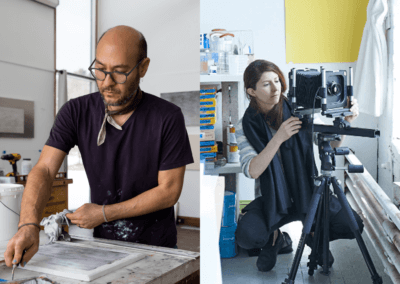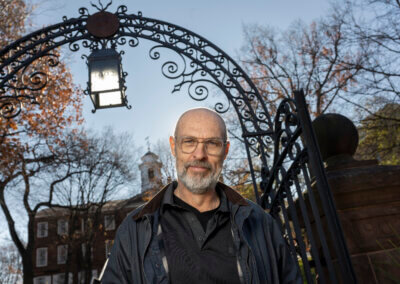RESEARCH & INNOVATION
Research and creative innovation are fundamental to what we do at Mason Gross School of the Arts. We view artistic practice and scholarly research as equally important and impactful forms of knowledge creation. As an arts conservatory at a public research university in a diverse region with a robust arts scene, Mason Gross is uniquely positioned to forge new paths in the study and practice of the arts—to create new knowledge about and through the arts in ways that are rigorous, inclusive, exploratory, and engaged.
Mason Gross is home to a world-renowned faculty that conducts research and actively fosters a culture of research among our students. See the full faculty directory for a more detailed look at faculty work.
Mason Gross also houses several innovative research centers and initiatives that stand at the leading edge of their disciplines and demonstrate our commitment to arts-integrated research. Read about the innovative work of these research centers and initiatives.
Research at Mason Gross
Meet Our Director of Research
Dr. Stephanie Cronenberg of the Mason Gross Music Department serves as the school’s inaugural Director of Research. This new position was established to build infrastructure for research at Mason Gross, to augment the interdisciplinary initiatives already underway, and to help enhance MGSA’s standing across the university and beyond.
What is research at Mason Gross?
Mason Gross School of the Arts is home to researchers who are forging new understandings of and through the arts. As a school, we view the study and practice of the arts as inseparable and equally important forms of research, since both study and practice have the potential to create new knowledge. Some of our faculty members engage in research by writing groundbreaking studies of the history, theory, perception, meaning, and practice of the arts across time periods and cultural contexts. Other faculty members at Mason Gross use their artistic media—from musical composition to dance improvisation, from documentary filmmaking to sculpture—to explore ideas and pressing issues confronting society today. Rooting their artistic practice in broad understandings and committed engagement with the world around them, these faculty members create art that challenges audiences and viewers to rethink the world and their place in it. While every research project and area are different, the Mason Gross Future Roadmap [PDF] has laid out a vision for collaborative and community-engaged research that will advance interdisciplinary thinking and advance the public good. To discuss possible research collaborations, please contact Stephanie Cronenberg, director of research at Mason Gross.
Can students engage in research at Mason Gross?
Yes! At Mason Gross, our world-renowned faculty guide their students to participate in innovative research in many contexts. Students learn to ask productive questions and develop new paradigms that will shape their disciplines and help to address the most pressing issues facing our society. Undergraduate students work with faculty to create new work that pushes at the boundaries of their fields, and they are also encouraged to participate in university-wide programs like Byrne First-Year Seminars and the Aresty Research Assistant Program to develop the habits and skills of researchers. Students in our rigorous, pioneering graduate programs learn to participate in the most current practices and conversations in their fields.
What is arts-integrated research?
Arts-integrated research involves the incorporation of arts mindsets—“the mindsets and practices of creativity and making”—into interdisciplinary research. We believe that every research initiative in every discipline can benefit from arts integration, since the arts offer new ways to perceive, comprehend, communicate, inspire, galvanize, and advocate. To spark new collaborative, arts-integrated research, Mason Gross School of the Arts recently developed a model for “speed networking,” which we implemented for the first time in 2021, first with the Rutgers School of Public Health and then with the School of Environmental and Biological Sciences. These “speed networking” programs have yielded early funding successes through an internal seed grant opportunity and through the Rutgers Research Council, and this system has since been adopted as a campus-wide model by the Office of the Vice Provost for Research at Rutgers-New Brunswick and a signature “Excellence” program by the Office of the President.
Rutgers University has signaled its commitment to arts-integrated research by becoming a member of a2ru (the Alliance for the Arts in Research Universities), a national consortium of research universities seeking to advance arts-integrated research and pedagogy.
Faculty Research Resources
MGSA Resources
- Help us celebrate your recent achievement by sharing your accomplishment on the Research Achievements page!
- MGSA’s Research & Professional Activity Fund (for full-time faculty).
- Get involved with the work of one of the MGSA Research Centers or Initiatives.
- Contact MGSA’s Director of Research to discuss research projects and funding opportunities. Please contact the Director of Research before submitting an external grant application.
University-wide Resources
- Learn about university-wide resources and procedures at the Rutgers Office for Research and the Center for Faculty Success
- Get involved in university-wide interdisciplinary research initiatives through the Office of the Vice Provost for Research
- Involve undergraduates in your research by applying for an Aresty Research Assistant
Looking for research funding?
- The Rutgers Research Council provides funding for faculty research. A call for proposals is issued annually.
- Use the Pivot database to search for funding opportunities. New to Pivot? Visit the MGSA Research Resources Canvas site for help.
- Rutgers faculty can earn research funds by applying to teach Byrne Seminars.




